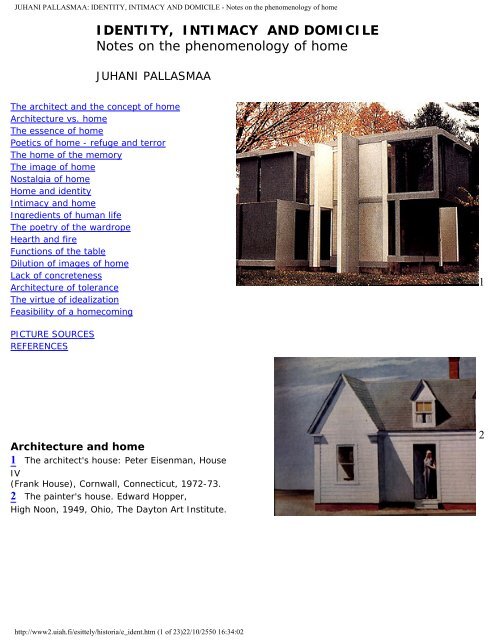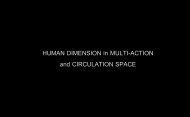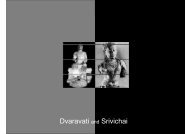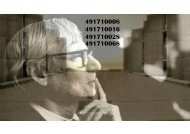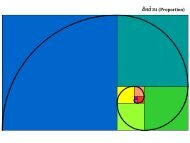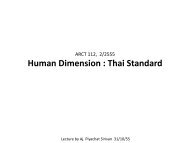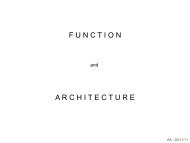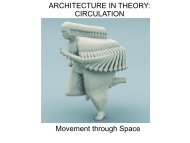IDENTITY INTIMACY AND DOMICILE Notes on the phenomenology of home
Notes on the phenomenology of home - Faculty of Architecture ...
Notes on the phenomenology of home - Faculty of Architecture ...
You also want an ePaper? Increase the reach of your titles
YUMPU automatically turns print PDFs into web optimized ePapers that Google loves.
JUHANI PALLASMAA: <str<strong>on</strong>g>IDENTITY</str<strong>on</strong>g>, <str<strong>on</strong>g>INTIMACY</str<strong>on</strong>g> <str<strong>on</strong>g>AND</str<strong>on</strong>g> <str<strong>on</strong>g>DOMICILE</str<strong>on</strong>g> - <str<strong>on</strong>g>Notes</str<strong>on</strong>g> <strong>on</strong> <strong>the</strong> <strong>phenomenology</strong> <strong>of</strong> <strong>home</strong><str<strong>on</strong>g>IDENTITY</str<strong>on</strong>g>, <str<strong>on</strong>g>INTIMACY</str<strong>on</strong>g> <str<strong>on</strong>g>AND</str<strong>on</strong>g> <str<strong>on</strong>g>DOMICILE</str<strong>on</strong>g><str<strong>on</strong>g>Notes</str<strong>on</strong>g> <strong>on</strong> <strong>the</strong> <strong>phenomenology</strong> <strong>of</strong> <strong>home</strong>JUHANI PALLASMAAThe architect and <strong>the</strong> c<strong>on</strong>cept <strong>of</strong> <strong>home</strong>Architecture vs. <strong>home</strong>The essence <strong>of</strong> <strong>home</strong>Poetics <strong>of</strong> <strong>home</strong> - refuge and terrorThe <strong>home</strong> <strong>of</strong> <strong>the</strong> memoryThe image <strong>of</strong> <strong>home</strong>Nostalgia <strong>of</strong> <strong>home</strong>Home and identityIntimacy and <strong>home</strong>Ingredients <strong>of</strong> human lifeThe poetry <strong>of</strong> <strong>the</strong> wardropeHearth and fireFuncti<strong>on</strong>s <strong>of</strong> <strong>the</strong> tableDiluti<strong>on</strong> <strong>of</strong> images <strong>of</strong> <strong>home</strong>Lack <strong>of</strong> c<strong>on</strong>cretenessArchitecture <strong>of</strong> toleranceThe virtue <strong>of</strong> idealizati<strong>on</strong>Feasibility <strong>of</strong> a <strong>home</strong>coming1PICTURE SOURCESREFERENCESArchitecture and <strong>home</strong>1 The architect's house: Peter Eisenman, HouseIV(Frank House), Cornwall, C<strong>on</strong>necticut, 1972-73.2 The painter's house. Edward Hopper,High No<strong>on</strong>, 1949, Ohio, The Dayt<strong>on</strong> Art Institute.2http://www2.uiah.fi/esittely/historia/e_ident.htm (1 <strong>of</strong> 23)22/10/2550 16:34:02
JUHANI PALLASMAA: <str<strong>on</strong>g>IDENTITY</str<strong>on</strong>g>, <str<strong>on</strong>g>INTIMACY</str<strong>on</strong>g> <str<strong>on</strong>g>AND</str<strong>on</strong>g> <str<strong>on</strong>g>DOMICILE</str<strong>on</strong>g> - <str<strong>on</strong>g>Notes</str<strong>on</strong>g> <strong>on</strong> <strong>the</strong> <strong>phenomenology</strong> <strong>of</strong> <strong>home</strong>The architect and <strong>the</strong> c<strong>on</strong>cept <strong>of</strong> <strong>home</strong>We architects are c<strong>on</strong>cerned with designing dwellings as architecturalmanifestati<strong>on</strong>s <strong>of</strong> space, structure and order, but we seem unable tOtouch up<strong>on</strong> <strong>the</strong> more subtle, emoti<strong>on</strong>al and diffuse aspects <strong>of</strong> <strong>home</strong>. In<strong>the</strong> schools <strong>of</strong> architecture we are taught to design houses and dwellings,not <strong>home</strong>s. Yet it is <strong>the</strong> capacity <strong>of</strong> <strong>the</strong> dwelling to provide domicile in <strong>the</strong>world that matters to <strong>the</strong> individual dweller. The dwelling has its psycheand soul in additi<strong>on</strong> to its formal and quantifiable qualities.The titles <strong>of</strong> architeCtural books invariably use <strong>the</strong> noti<strong>on</strong> <strong>of</strong> 'house'- 'TheModern House', 'GA-Houses', 'California Houses", ete. - whereas booksand magazines that deal with interior decorati<strong>on</strong> and celebrities prefer <strong>the</strong>noti<strong>on</strong> <strong>of</strong> '<strong>home</strong>' - 'Celebrity Homes', 'Artist Homes', etc.. Needless to saythat <strong>the</strong> publicati<strong>on</strong>s <strong>of</strong> <strong>the</strong> latter type are c<strong>on</strong>sidered sentimentalentertainment and kitsch by <strong>the</strong> pr<strong>of</strong>essi<strong>on</strong>al architect.Our c<strong>on</strong>cept <strong>of</strong> architecture is based <strong>on</strong> <strong>the</strong> idea <strong>of</strong> <strong>the</strong> perfectlyarticulated architectural object. The famous court case between Mies vander Rohe and his client, Dr. Edith Farnsworth, c<strong>on</strong>cerning <strong>the</strong> FarnsworthHouse, is an example <strong>of</strong> <strong>the</strong> c<strong>on</strong>tradicti<strong>on</strong> between architecture and <strong>home</strong>.As we all know, Mies had designed <strong>on</strong>e <strong>of</strong> <strong>the</strong> most important andaes<strong>the</strong>tically appealing houses <strong>of</strong> our century, but his client did not find itsatisfactory as a <strong>home</strong>. The court, incidentally, decided in Mies's favour. Iam not underrating Mies's architecture; I am simply pointing out <strong>the</strong>distancing from life and a deliberate reducti<strong>on</strong> <strong>of</strong> <strong>the</strong> spectrum <strong>of</strong> life.When we compare designs <strong>of</strong> Modernity with those <strong>of</strong> today's avant-garde,we immediately observe a loss <strong>of</strong> empathy for <strong>the</strong> dweller. Instead <strong>of</strong>being motivated by <strong>the</strong> architect's social visi<strong>on</strong>, or view <strong>of</strong> life,architecture has become self-referential and autistic.Many <strong>of</strong> us architects seem to have developed a kind <strong>of</strong> split pers<strong>on</strong>ality:as designers and as dwellers we apply different sets <strong>of</strong> values to <strong>the</strong>envir<strong>on</strong>ment. In our role as architects we aspire for a meticulouslyarticulated and temporally <strong>on</strong>edimensi<strong>on</strong>al envir<strong>on</strong>ment, whereas asdwellers ourselves, we prefer a more layered, ambiguous and aes<strong>the</strong>ticallyless coherent envir<strong>on</strong>ment; <strong>the</strong> instinctual dwellcr emerges through <strong>the</strong>role values <strong>of</strong> <strong>the</strong> pr<strong>of</strong>essi<strong>on</strong>al.http://www2.uiah.fi/esittely/historia/e_ident.htm (2 <strong>of</strong> 23)22/10/2550 16:34:02
JUHANI PALLASMAA: <str<strong>on</strong>g>IDENTITY</str<strong>on</strong>g>, <str<strong>on</strong>g>INTIMACY</str<strong>on</strong>g> <str<strong>on</strong>g>AND</str<strong>on</strong>g> <str<strong>on</strong>g>DOMICILE</str<strong>on</strong>g> - <str<strong>on</strong>g>Notes</str<strong>on</strong>g> <strong>on</strong> <strong>the</strong> <strong>phenomenology</strong> <strong>of</strong> <strong>home</strong>3 4Architecture and <strong>home</strong>3 Vincent van Gogh: Vincent's room inArles, 1888.4 Marcel Breuer: dining room <strong>of</strong> <strong>the</strong>Piscator House, Berlin, 1926.Architecture vs. <strong>home</strong>The questi<strong>on</strong> arises: can a <strong>home</strong> be an architectural expressi<strong>on</strong>? Home isnot, perhaps, at all a noti<strong>on</strong> <strong>of</strong> architecture, but <strong>of</strong> psychology,psychoanalysis and sociology.Home is an individualized dwelling, and <strong>the</strong> means <strong>of</strong> this subtlepers<strong>on</strong>alizati<strong>on</strong> seem to be outside our noti<strong>on</strong> <strong>of</strong> architecture. Dwelling, ahouse, is <strong>the</strong> c<strong>on</strong>tainer, <strong>the</strong> shell for <strong>home</strong>. The substance <strong>of</strong> <strong>home</strong> issecreted, as it were, up<strong>on</strong> <strong>the</strong> framework <strong>of</strong> <strong>the</strong> dwelling by <strong>the</strong> dweller.Home is an expressi<strong>on</strong> <strong>of</strong> pers<strong>on</strong>ality and family and <strong>the</strong>ir very uniquepatterns <strong>of</strong> life. C<strong>on</strong>sequently, <strong>the</strong> essence <strong>of</strong> <strong>home</strong> is eloser to life itselfthan to artefact.The architectural dimensi<strong>on</strong> <strong>of</strong> <strong>the</strong> house and <strong>the</strong> pers<strong>on</strong>al and privatedimensi<strong>on</strong> <strong>of</strong> life have become totally fused in our time <strong>of</strong> excessivespecializati<strong>on</strong> <strong>on</strong>ly in certain cases, such as Alvar Aalto's Villa Mairea,which is a product <strong>of</strong> an excepti<strong>on</strong>al friendship and interacti<strong>on</strong> betwcen <strong>the</strong>arehitect and his client, an opus c<strong>on</strong> amore, as Aalto himself hasc<strong>on</strong>fessed 1. Equally important, it is <strong>the</strong> expressi<strong>on</strong> <strong>of</strong> a mutually sharedutopian visi<strong>on</strong> <strong>of</strong> a better and more humane world.Villa Mairea is archaic and modern, rustic and elegant, regi<strong>on</strong>al andhttp://www2.uiah.fi/esittely/historia/e_ident.htm (3 <strong>of</strong> 23)22/10/2550 16:34:02
JUHANI PALLASMAA: <str<strong>on</strong>g>IDENTITY</str<strong>on</strong>g>, <str<strong>on</strong>g>INTIMACY</str<strong>on</strong>g> <str<strong>on</strong>g>AND</str<strong>on</strong>g> <str<strong>on</strong>g>DOMICILE</str<strong>on</strong>g> - <str<strong>on</strong>g>Notes</str<strong>on</strong>g> <strong>on</strong> <strong>the</strong> <strong>phenomenology</strong> <strong>of</strong> <strong>home</strong>universal at <strong>the</strong> same time. It refers simultaneously to <strong>the</strong> past and <strong>the</strong>future, it is abundant in its imagery and, c<strong>on</strong>sequently, provides ample soilfor individual psychie attachement. In his book 'Poeties <strong>of</strong> Space' 2, whichdeals with <strong>the</strong> psyche <strong>of</strong> space, Gast<strong>on</strong> Bachelard deliberates <strong>on</strong> <strong>the</strong>essence <strong>of</strong> <strong>the</strong> <strong>on</strong>eiric house, <strong>the</strong> house <strong>of</strong> <strong>the</strong> mind. He is undecidedabout <strong>the</strong> number <strong>of</strong> floors <strong>of</strong> this archetypal house; it has ei<strong>the</strong>r three orfour floors. But <strong>the</strong> existence <strong>of</strong> an attic and a cellar are essential, because<strong>the</strong> attic is <strong>the</strong> symbolic storage place for pleasant memories that <strong>the</strong>dweller wants to return to, whereas <strong>the</strong> cellar is <strong>the</strong> hiding place forunpleasant memories; both are needed for our mental well-being.It is evident that <strong>the</strong> charaeteristics <strong>of</strong> <strong>the</strong> Oneiric house are culturallyc<strong>on</strong>diti<strong>on</strong>al but, <strong>on</strong> <strong>the</strong> o<strong>the</strong>r hand, <strong>the</strong> image seems to rcflect universalc<strong>on</strong>stants <strong>of</strong> <strong>the</strong> human mind. Modern architecture has forcefullyattempted to avoid or eliminate this <strong>on</strong>eiric image. C<strong>on</strong>sequently, it is notsurprising that Modern Man's rejecti<strong>on</strong> <strong>of</strong> history has been accompaniedby <strong>the</strong> rejecti<strong>on</strong> <strong>of</strong> psychic memory attaehed to primal images. Theobsessi<strong>on</strong> with newness, <strong>the</strong> n<strong>on</strong>-traditi<strong>on</strong>al and <strong>the</strong> unforeseen has wipedaway <strong>the</strong> image <strong>of</strong> <strong>the</strong> house from our soul.We build dwellings that, perhaps, satisfy most <strong>of</strong> our physical needs, butwhich do not house our mind.5 6Home and <strong>the</strong> inhabitant's identity5 John Wayne's living room. 6 John Wayne.http://www2.uiah.fi/esittely/historia/e_ident.htm (4 <strong>of</strong> 23)22/10/2550 16:34:02
JUHANI PALLASMAA: <str<strong>on</strong>g>IDENTITY</str<strong>on</strong>g>, <str<strong>on</strong>g>INTIMACY</str<strong>on</strong>g> <str<strong>on</strong>g>AND</str<strong>on</strong>g> <str<strong>on</strong>g>DOMICILE</str<strong>on</strong>g> - <str<strong>on</strong>g>Notes</str<strong>on</strong>g> <strong>on</strong> <strong>the</strong> <strong>phenomenology</strong> <strong>of</strong> <strong>home</strong>The essence <strong>of</strong> <strong>home</strong>It is evident that <strong>home</strong> is not an object, a building, but a diffuse andcomplex c<strong>on</strong>diti<strong>on</strong> that integrates memories and images, desires andfears, <strong>the</strong> past and <strong>the</strong> present. A <strong>home</strong> is also a set <strong>of</strong> rituals, pers<strong>on</strong>alrhythms and routines <strong>of</strong> everyday life. Home cannot he produced all at<strong>on</strong>ce; it has its time dimensi<strong>on</strong> and c<strong>on</strong>tinuum and is a gradual product <strong>of</strong><strong>the</strong> family's and individual's adaptati<strong>on</strong> to <strong>the</strong> world. A <strong>home</strong> cannot, thus,become a marketable product. Current advertisements <strong>of</strong> furniture shops<strong>of</strong>fering a chance 'to renew <strong>on</strong>e's <strong>home</strong> at <strong>on</strong>e go' are absurd - <strong>the</strong>yamount to a psychologist's advertisement to renew <strong>the</strong> mental c<strong>on</strong>tents <strong>of</strong><strong>the</strong> patient's mind at <strong>on</strong>e go.Reflecti<strong>on</strong> <strong>on</strong> <strong>the</strong> essence <strong>of</strong> <strong>home</strong> takes us away from <strong>the</strong> physicalproperties <strong>of</strong> a house into <strong>the</strong> psychic territory <strong>of</strong> <strong>the</strong> mind. It engages uswith issues <strong>of</strong> identity and memory, c<strong>on</strong>sciousness and <strong>the</strong> unc<strong>on</strong>scious,biologically motivated behavioural remnants as well as culturallyc<strong>on</strong>diti<strong>on</strong>ed reacti<strong>on</strong>s and values.7 8Home and fear7 Rene Magritte: The Tomb <strong>of</strong> a Wrestler, 1960.Collecti<strong>on</strong> Harry Torezyner, New York City.8 Alfred Hitchcock: The Rear Window 1954.http://www2.uiah.fi/esittely/historia/e_ident.htm (5 <strong>of</strong> 23)22/10/2550 16:34:02
JUHANI PALLASMAA: <str<strong>on</strong>g>IDENTITY</str<strong>on</strong>g>, <str<strong>on</strong>g>INTIMACY</str<strong>on</strong>g> <str<strong>on</strong>g>AND</str<strong>on</strong>g> <str<strong>on</strong>g>DOMICILE</str<strong>on</strong>g> - <str<strong>on</strong>g>Notes</str<strong>on</strong>g> <strong>on</strong> <strong>the</strong> <strong>phenomenology</strong> <strong>of</strong> <strong>home</strong>Poetics <strong>of</strong> <strong>home</strong> - refuge and terrorThe descripti<strong>on</strong> <strong>of</strong> <strong>home</strong> seems to bel<strong>on</strong>g more to <strong>the</strong> .realms <strong>of</strong> poetry,<strong>the</strong> novel, film and painting more than to architecture.'Poets and painters are born phenomenologists', as J.H. van den Berg hasremarked 3. And so, in my view, are novelists, photographers and filmdirectors. That is why <strong>the</strong> essence <strong>of</strong> <strong>home</strong>, its functi<strong>on</strong> as a mirror andsupport <strong>of</strong> <strong>the</strong> inhabitant's psyche is <strong>of</strong>ten more revealingly pictured in<strong>the</strong>se art forms than in architecture. In <strong>the</strong> recent Berlage Papers(January 1994) <strong>the</strong> filmmaker Jan Vrijman makes this thought-provokingremark: '... why is it that architecture and architects, unlike film andfilmmakers, are so little interested in people during <strong>the</strong> design process?Why are <strong>the</strong>y so <strong>the</strong>oretical, so distant from life in general?'The artist is not c<strong>on</strong>cerned with <strong>the</strong> principles and intenti<strong>on</strong>s <strong>of</strong> <strong>the</strong>discipline <strong>of</strong> architecture and, c<strong>on</strong>sequently, he approaches <strong>the</strong> mentalsignificance <strong>of</strong> images <strong>of</strong> <strong>the</strong> house and <strong>the</strong> <strong>home</strong> directly. Thus, artworksdealing with space, light, buildings and dwelling, provide valuable less<strong>on</strong>sto architects <strong>on</strong> <strong>the</strong> very essence <strong>of</strong> architecture itself.Jean-Paul Sartre has written perceptively about <strong>the</strong> au<strong>the</strong>nticity <strong>of</strong> <strong>the</strong>artist's house: '(The painter) makes <strong>the</strong>m (houses), that is, he creates animaginary house <strong>on</strong> <strong>the</strong> canvas and not a sign <strong>of</strong> a house. And <strong>the</strong> house,which thus appears preserves all <strong>the</strong> ambiguity <strong>of</strong> real houses'. 4As well as being a symbol <strong>of</strong> protecti<strong>on</strong> and order, <strong>home</strong> can, in negativelife situati<strong>on</strong>s, become a c<strong>on</strong>cretizati<strong>on</strong> <strong>of</strong> human misery: <strong>of</strong> l<strong>on</strong>eliness,rejecti<strong>on</strong>, exploitati<strong>on</strong> and violence.In <strong>the</strong> opening chapter <strong>of</strong> 'Crime and Punishment', Raskolnikov visits <strong>the</strong><strong>home</strong> <strong>of</strong> <strong>the</strong> old usurer woman, his future victim, and Dostojevsky gives alac<strong>on</strong>ic but haunting descripti<strong>on</strong> <strong>of</strong> <strong>the</strong> <strong>home</strong>, which eventually turns into<strong>the</strong> scene <strong>of</strong> <strong>the</strong> murder. Home turns from a symbol <strong>of</strong> security to asymbol <strong>of</strong> threat and violence.The <strong>home</strong> interiors <strong>of</strong> Balthus reflect strange sexual tensi<strong>on</strong>s - <strong>the</strong> <strong>home</strong>has become eroticized - whereas Hitchcock charges <strong>the</strong> most ordinary<strong>home</strong> with extraordinary threat, as in <strong>the</strong> films 'The Rear Window','Marnie' and 'The Rope'. Home is an intra-psychic and multidimensi<strong>on</strong>alexperience that is difficult to describe objectively. Thus an introspectiveand phenomenological survey <strong>of</strong> images, emoti<strong>on</strong>s, experiences andrecollecti<strong>on</strong>s <strong>of</strong> <strong>home</strong> seems to be a fruitful approach in analysing thisnoti<strong>on</strong> that we all c<strong>on</strong>stantly use, but rarely stop to analyse.http://www2.uiah.fi/esittely/historia/e_ident.htm (6 <strong>of</strong> 23)22/10/2550 16:34:02
JUHANI PALLASMAA: <str<strong>on</strong>g>IDENTITY</str<strong>on</strong>g>, <str<strong>on</strong>g>INTIMACY</str<strong>on</strong>g> <str<strong>on</strong>g>AND</str<strong>on</strong>g> <str<strong>on</strong>g>DOMICILE</str<strong>on</strong>g> - <str<strong>on</strong>g>Notes</str<strong>on</strong>g> <strong>on</strong> <strong>the</strong> <strong>phenomenology</strong> <strong>of</strong> <strong>home</strong>9 10The painful memory <strong>of</strong> <strong>home</strong>9 Andrey Tarkovsky: The Mirror, 1975. 10 Andrey Tarkovsky: Nostalgia, 1983.The <strong>home</strong> <strong>of</strong> <strong>the</strong> memoryThe word <strong>home</strong> makes us suddenly and simultaneously remember all <strong>the</strong>warmth, protecti<strong>on</strong> and love <strong>of</strong> our entire childhood. Perhaps, our <strong>home</strong>s<strong>of</strong> adulthood are <strong>on</strong>ly an unc<strong>on</strong>scious search for <strong>the</strong> lost <strong>home</strong> <strong>of</strong>childhood.But, <strong>the</strong> memory <strong>of</strong> <strong>home</strong> also awakens all <strong>the</strong> distress and fear that wemay have experienced in our childhood.'A house c<strong>on</strong>stitutes a body <strong>of</strong> images that give mankind pro<strong>of</strong>s or illusi<strong>on</strong>s<strong>of</strong> stability 5, and, 'It is an instrument with which to c<strong>on</strong>fr<strong>on</strong>t <strong>the</strong> cosmos'6, Bachelard writes. And he is speaking about <strong>the</strong> <strong>home</strong>, a house filledwith <strong>the</strong> essence <strong>of</strong> pers<strong>on</strong>al life. Home is a collecti<strong>on</strong> and c<strong>on</strong>cretizati<strong>on</strong><strong>of</strong> pers<strong>on</strong>al images <strong>of</strong> protecti<strong>on</strong> and intimacy that help us recognize andremember who we are.Home is a staging <strong>of</strong> pers<strong>on</strong>al memory. It functi<strong>on</strong>s as a two-way mediator- pers<strong>on</strong>al space expresses <strong>the</strong> pers<strong>on</strong>ality to <strong>the</strong> outside world, but,equally important, it streng<strong>the</strong>ns <strong>the</strong> dweller's self-image and c<strong>on</strong>cretizeshis world order. Home is also a mediator between intimacy and public life.In <strong>the</strong>ir influential book 'Community and Privacy 7 <strong>of</strong> 1963, ChristopherAlexander and Serge Chermayeff identified six spatial mechanismsbetween <strong>the</strong> polarities <strong>of</strong> private and public.The image <strong>of</strong> <strong>home</strong>http://www2.uiah.fi/esittely/historia/e_ident.htm (7 <strong>of</strong> 23)22/10/2550 16:34:02
JUHANI PALLASMAA: <str<strong>on</strong>g>IDENTITY</str<strong>on</strong>g>, <str<strong>on</strong>g>INTIMACY</str<strong>on</strong>g> <str<strong>on</strong>g>AND</str<strong>on</strong>g> <str<strong>on</strong>g>DOMICILE</str<strong>on</strong>g> - <str<strong>on</strong>g>Notes</str<strong>on</strong>g> <strong>on</strong> <strong>the</strong> <strong>phenomenology</strong> <strong>of</strong> <strong>home</strong>Before I reached high-school age, my family moved several times due tomy fa<strong>the</strong>r's job and, c<strong>on</strong>sequently, I lived in seven different houses duringmy childhood. In additi<strong>on</strong>, I spent my childhood summers and most <strong>of</strong> <strong>the</strong>war in my farmer grandfa<strong>the</strong>r's house. Regardless <strong>of</strong> having lived in eighthouses, I have <strong>on</strong>ly had <strong>on</strong>e experiential <strong>home</strong> in my childhood; myexperiential <strong>home</strong> seems to have travelled with me and been c<strong>on</strong>stantlytransformed to new physical shapes as we moved.I cannot recall <strong>the</strong> exact architectural shape or layout <strong>of</strong> any <strong>of</strong> <strong>the</strong> eighthouses. But I do recall vividly <strong>the</strong> sense <strong>of</strong> <strong>home</strong>, <strong>the</strong> feeling <strong>of</strong> returning<strong>home</strong> from a skiing trip in <strong>the</strong> darkness <strong>of</strong> a cold winter evening. Theexperienee <strong>of</strong> <strong>home</strong> is never str<strong>on</strong>ger than when seeing <strong>the</strong> windows <strong>of</strong><strong>the</strong> house lit in <strong>the</strong> dark winter landscape and sensing <strong>the</strong> invitati<strong>on</strong> <strong>of</strong>warmth warming your frozen limbs. 'Light in <strong>the</strong> window <strong>of</strong> <strong>the</strong> <strong>home</strong> is awaiting light' 8, as Bachelard has observed. The <strong>home</strong> has a soul. I cannotrecall <strong>the</strong> shape <strong>of</strong> <strong>the</strong> fr<strong>on</strong>t door <strong>of</strong> my grandfa<strong>the</strong>r's house ei<strong>the</strong>r, but Ican still sense <strong>the</strong> warmth and odour <strong>of</strong> air flowing against my face as Iopen <strong>the</strong> door.In an essay entitled 'The Geometry <strong>of</strong> Feeling' (1985) 9, I have dealt with<strong>the</strong> properties <strong>of</strong> lived space as compared to comm<strong>on</strong> noti<strong>on</strong>s <strong>of</strong>architecture. It seems to me that emoti<strong>on</strong>s deriving from built form andspace arise from distinct c<strong>on</strong>fr<strong>on</strong>tati<strong>on</strong>s between man and space. Theemoti<strong>on</strong>al impact is related to an act, not an object or a visual or figuralelement. The <strong>phenomenology</strong> <strong>of</strong> arehitecture is founded <strong>on</strong> verbs ra<strong>the</strong>rthan nouns. The approaching <strong>of</strong> <strong>the</strong> house, not <strong>the</strong> facade, <strong>the</strong> act <strong>of</strong>entering, not <strong>the</strong> door; <strong>the</strong> act <strong>of</strong> looking out <strong>of</strong> <strong>the</strong> window, not <strong>the</strong>window itself; or <strong>the</strong> act <strong>of</strong> ga<strong>the</strong>ring around ra<strong>the</strong>r than <strong>the</strong> hearth or <strong>the</strong>table as such seem to trigger our str<strong>on</strong>gest emoti<strong>on</strong>s.Nostalgia <strong>of</strong> <strong>home</strong>I also remember <strong>the</strong> sadness and secret threat <strong>of</strong> leaving <strong>the</strong> <strong>home</strong> as wemoved to ano<strong>the</strong>r town. The greatest tragedy was <strong>the</strong> fear <strong>of</strong> facing anunknown future and losing <strong>on</strong>e's childhood friends.It is clear that <strong>the</strong> experience <strong>of</strong> <strong>home</strong> c<strong>on</strong>sists <strong>of</strong> and integrates anincredible array <strong>of</strong> mental dimensi<strong>on</strong>s from that <strong>of</strong> nati<strong>on</strong>ality and beingsubject to a specific culture to those <strong>of</strong> unc<strong>on</strong>scious desires and fears. Now<strong>on</strong>der sociologists have found out that <strong>the</strong> sorrow for a lost <strong>home</strong> am<strong>on</strong>gslum residents is very similar to <strong>the</strong> mourning a lost relative.There is a strange melancholy in an aband<strong>on</strong>ed <strong>home</strong> or a demolishedapartment house that reveals traces and scars <strong>of</strong> intimate lives to <strong>the</strong>http://www2.uiah.fi/esittely/historia/e_ident.htm (8 <strong>of</strong> 23)22/10/2550 16:34:02
JUHANI PALLASMAA: <str<strong>on</strong>g>IDENTITY</str<strong>on</strong>g>, <str<strong>on</strong>g>INTIMACY</str<strong>on</strong>g> <str<strong>on</strong>g>AND</str<strong>on</strong>g> <str<strong>on</strong>g>DOMICILE</str<strong>on</strong>g> - <str<strong>on</strong>g>Notes</str<strong>on</strong>g> <strong>on</strong> <strong>the</strong> <strong>phenomenology</strong> <strong>of</strong> <strong>home</strong>public gaze <strong>on</strong> its crumbling walls. It is touching to come across <strong>the</strong>remains <strong>of</strong> foundati<strong>on</strong>s or <strong>the</strong> hearth <strong>of</strong> a ruined or burnt house, halfburied in <strong>the</strong> forest grass. The tenderness <strong>of</strong> <strong>the</strong> experienee results from<strong>the</strong> fact that we do not imagine <strong>the</strong> house, but <strong>the</strong> <strong>home</strong>, life and faith <strong>of</strong>its members.Andrej Tarkovsky's film 'Nostalgia' is a touching record <strong>of</strong> <strong>the</strong> loss <strong>of</strong> andgrievance for <strong>home</strong> 10. It is a film about <strong>the</strong> nostalgia for an absent <strong>home</strong>that is typical <strong>of</strong> Russian sentiment from <strong>the</strong> times <strong>of</strong> Dostojevsky andGogol to Tarkovsky. Throughout <strong>the</strong> film <strong>the</strong> central figure, <strong>the</strong> poetAndrej Gorchakov, keeps fingering <strong>the</strong> keys to his <strong>home</strong> in Russia in <strong>the</strong>pocket <strong>of</strong> his overcoat as an unc<strong>on</strong>scious reflecti<strong>on</strong> <strong>of</strong> his l<strong>on</strong>ging for<strong>home</strong>. All <strong>of</strong> Tarkovsky's films, in fact, seem to deal with nostalgia for <strong>the</strong>absent domicile 11.In <strong>the</strong> Communist state, <strong>home</strong> turned from a refuge into a place <strong>of</strong>surveillance, a c<strong>on</strong>centrati<strong>on</strong> camp. And <strong>home</strong> turned into a mysticaldream that many Russian artists have described in <strong>the</strong>ir works.Home and identityThe interdependence <strong>of</strong> identity and c<strong>on</strong>text is so str<strong>on</strong>g thatpsychologists speak <strong>of</strong> a 'situati<strong>on</strong>al pers<strong>on</strong>ality'. The noti<strong>on</strong> has beenc<strong>on</strong>ceived <strong>on</strong> <strong>the</strong> basis <strong>of</strong> <strong>the</strong> observati<strong>on</strong> that <strong>the</strong> behaviour <strong>of</strong> anindividual varies more under different c<strong>on</strong>diti<strong>on</strong>s than <strong>the</strong> behaviour <strong>of</strong>different individuals under <strong>the</strong> same c<strong>on</strong>diti<strong>on</strong>s.The psycho-linguistic studies <strong>of</strong> <strong>the</strong> Norwegian born Finn, Frode Strömnes,have disclosed out fur<strong>the</strong>r dimensi<strong>on</strong>s in <strong>the</strong> interdependence <strong>of</strong> psycheand c<strong>on</strong>text. In his research <strong>on</strong> imagery as <strong>the</strong> basis <strong>of</strong> linguisticoperati<strong>on</strong>s, he has revealed that even language c<strong>on</strong>diti<strong>on</strong>s our c<strong>on</strong>cepti<strong>on</strong>and utilizati<strong>on</strong> <strong>of</strong> space 12. C<strong>on</strong>sequently our c<strong>on</strong>cept <strong>of</strong> <strong>home</strong> is foundedin language; our first <strong>home</strong> is in <strong>the</strong> domicile <strong>of</strong> our mo<strong>the</strong>r t<strong>on</strong>gue. Andlanguage is str<strong>on</strong>gly tied up with our bodily existence, <strong>the</strong> unc<strong>on</strong>sciousgeometry <strong>of</strong> our language articulates our being in <strong>the</strong> world.Home is a projecti<strong>on</strong> and basis <strong>of</strong> identity, not <strong>on</strong>ly <strong>of</strong> an individual butalso <strong>of</strong> <strong>the</strong> family. But <strong>home</strong>s, <strong>the</strong> mere secrecy <strong>of</strong> private lives c<strong>on</strong>cealedfrom <strong>the</strong> public eye, also structure social life. Homes delineate <strong>the</strong> realms<strong>of</strong> intimacy and public life. It is frustrating to he forced to live in a spacethat we cannot recognize or mark as our pers<strong>on</strong>al territory. An an<strong>on</strong>ymoushotel room is immediately pers<strong>on</strong>alized and taken into possessi<strong>on</strong> bysubtly marking <strong>the</strong> territory -laying out clo<strong>the</strong>s, books, objects, opening<strong>the</strong> bed, ete. The minimum <strong>home</strong> <strong>of</strong> <strong>the</strong> child or a primitive is <strong>the</strong> mascotor <strong>the</strong> pers<strong>on</strong>al idol that gives a sense <strong>of</strong> safety and normality. My fivehttp://www2.uiah.fi/esittely/historia/e_ident.htm(9 <strong>of</strong> 23)22/10/2550 16:34:02
JUHANI PALLASMAA: <str<strong>on</strong>g>IDENTITY</str<strong>on</strong>g>, <str<strong>on</strong>g>INTIMACY</str<strong>on</strong>g> <str<strong>on</strong>g>AND</str<strong>on</strong>g> <str<strong>on</strong>g>DOMICILE</str<strong>on</strong>g> - <str<strong>on</strong>g>Notes</str<strong>on</strong>g> <strong>on</strong> <strong>the</strong> <strong>phenomenology</strong> <strong>of</strong> <strong>home</strong>year-old daughter cannot go anywhere without her scratching pillow, myAmerican architect assistant travelled to Finland with four books (Joyce'sUlysses, T.S. Eliot's Four Quartets and two books <strong>on</strong> American poetry, by<strong>the</strong> way), while an American architect woman friend travels with her set <strong>of</strong>kitchen knives, which are her magical instruments for recreating a sense<strong>of</strong> <strong>home</strong>.11 12The intimacy <strong>of</strong> <strong>home</strong>11 René Magritte: The M<strong>on</strong>th <strong>of</strong> <strong>the</strong> GrapeHarvest, 1959, Private Collecti<strong>on</strong>, Paris.12 Edward Hopper: Eleven A.M., 1926.Hirschhorn Museum and Sculpture Garden,Smiths<strong>on</strong>ian Institute, Washingt<strong>on</strong>, D.C.Intimacy and <strong>home</strong>We have private and social pers<strong>on</strong>alities and <strong>home</strong> is <strong>the</strong> realm <strong>of</strong> <strong>the</strong>former. Home is <strong>the</strong> place where we hide our secrets and express ourprivate selves. Home is our place <strong>of</strong> resting and dreaming in safety. Moreprecisely, <strong>the</strong> role <strong>of</strong> <strong>home</strong> as delineator or mediator between <strong>the</strong> realms<strong>of</strong> public and private, <strong>the</strong> transparency <strong>of</strong> <strong>the</strong> <strong>home</strong> as it were, variesgreatly. There are ways <strong>of</strong> life in which <strong>home</strong> has become a publicshowcase and <strong>the</strong> public gaze penetrates <strong>the</strong> secrecy <strong>of</strong> <strong>home</strong>.Generally, however, <strong>the</strong> intimacy <strong>of</strong> <strong>home</strong> is almost a taboo in our culture.We have a feeling <strong>of</strong> guilt and embarrassment if we, for some reas<strong>on</strong>, areobliged to enter some<strong>on</strong>e's <strong>home</strong> uninvited when <strong>the</strong> occupant is not at<strong>home</strong>. To see an unattended <strong>home</strong> is <strong>the</strong> same as seeing its dweller nakedor in his most intimate situati<strong>on</strong>.In his Notebooks <strong>of</strong>'Malte Laurids Brigge', Rainer Maria Rilke gives apowerful descripti<strong>on</strong> <strong>of</strong> <strong>the</strong> marks <strong>of</strong> intimacy, <strong>the</strong> lives in a house thathad already been demolished but which could still he seen in traces left <strong>on</strong>http://www2.uiah.fi/esittely/historia/e_ident.htm (10 <strong>of</strong> 23)22/10/2550 16:34:02
JUHANI PALLASMAA: <str<strong>on</strong>g>IDENTITY</str<strong>on</strong>g>, <str<strong>on</strong>g>INTIMACY</str<strong>on</strong>g> <str<strong>on</strong>g>AND</str<strong>on</strong>g> <str<strong>on</strong>g>DOMICILE</str<strong>on</strong>g> - <str<strong>on</strong>g>Notes</str<strong>on</strong>g> <strong>on</strong> <strong>the</strong> <strong>phenomenology</strong> <strong>of</strong> <strong>home</strong><strong>the</strong> wall <strong>of</strong> its neighbouring building. These traces <strong>of</strong> life enabled Brigge torecreate his own past. Rilke describes with staggering force how lifepenetrates dead matter; <strong>the</strong> history <strong>of</strong> life can he traced in <strong>the</strong> minutestfragment <strong>of</strong> <strong>the</strong> dwelling."But <strong>the</strong> walls <strong>the</strong>mselves were <strong>the</strong> most unforgettable. The stubborn life<strong>of</strong> <strong>the</strong>se rooms had not allowed itself to be trampled out. It was still <strong>the</strong>re;it clung to <strong>the</strong> nails that had been left in <strong>the</strong> walls; it found a resting-place<strong>on</strong> <strong>the</strong> remaining handbreadth <strong>of</strong> flooring; it squatted beneath <strong>the</strong> cornerbeams where a little bit <strong>of</strong> space remained. One could see it in <strong>the</strong> colourswhich it had slowly changed, year by year: blue into a mouldy green,green into grey, and yellow into a stale, drab, weary white. But it was alsoin <strong>the</strong> places that had kept fresher, behind <strong>the</strong> mirrors, <strong>the</strong> pictures, and<strong>the</strong> wardrobes; for it bad outlined <strong>the</strong>ir c<strong>on</strong>tours over and over again, andhad been with cobwebs and dust even in <strong>the</strong>se hidden retreats that nowlay uncovered. It was in every bare, flayed streak <strong>of</strong> surface, it was in <strong>the</strong>blisters <strong>the</strong> dampness had raised at <strong>the</strong> edges <strong>of</strong> <strong>the</strong> wallpapers; it floatedin <strong>the</strong> torn-<strong>of</strong>f shreds, and sweated out <strong>of</strong> <strong>the</strong> l<strong>on</strong>g-standing spots <strong>of</strong> filth.And from <strong>the</strong>se walls <strong>on</strong>ce blue, and green and yellow, framed by <strong>the</strong>tracks <strong>of</strong> <strong>the</strong> disturbed partiti<strong>on</strong>s, <strong>the</strong> breath <strong>of</strong> <strong>the</strong>se lives came forth -<strong>the</strong> clammy, stuggish, fusty breath, which no wind had yet scattered.There were <strong>the</strong> midday meals and <strong>the</strong> sicknesses and <strong>the</strong> exhalati<strong>on</strong>s and<strong>the</strong> smoke <strong>of</strong> years, and <strong>the</strong> stale breath <strong>of</strong> mouths, and <strong>the</strong> oily odour <strong>of</strong>perspiring feet. There were <strong>the</strong> pungent tang <strong>of</strong> urine and <strong>the</strong> stench <strong>of</strong>burning soot and <strong>the</strong> grey reek <strong>on</strong> potatoes, and <strong>the</strong> heavy, sickly fumes<strong>of</strong> rancid grease. The sweetish, lingering smell <strong>of</strong> neglected infants was<strong>the</strong>re, and <strong>the</strong> smell <strong>of</strong> frightened children who go to school, and <strong>the</strong>stuffiness <strong>of</strong> <strong>the</strong> beds <strong>of</strong> nubile youths. 13I apologize for <strong>the</strong> lengthy quote, but I wanted to point out how lifepenetrates verbal images <strong>of</strong> a great poem as compared to <strong>the</strong> sterilizedimages <strong>of</strong> c<strong>on</strong>temporary architecture.In its emoti<strong>on</strong>al power, Rilke's descripti<strong>on</strong> reminds <strong>on</strong>e <strong>of</strong> Heidegger'sfamous descripti<strong>on</strong> <strong>of</strong> <strong>the</strong> epic message <strong>of</strong> van Gogh's Peasant's shoes. 14The later questi<strong>on</strong>ing <strong>of</strong> <strong>the</strong> relevance <strong>of</strong> Heidegger's interpretati<strong>on</strong> byMeyer Shapiro does not diminish <strong>the</strong> poetic power <strong>of</strong> his descripti<strong>on</strong>: hehas pointed out ihat van Gogh actually painted his own shoes and,besides, he did <strong>the</strong> painting during his short stay in Paris. What isimportant, however, is <strong>the</strong> artist's extraordinary dense imagery thatreflects an au<strong>the</strong>ntic form <strong>of</strong> life.In <strong>the</strong> intimate polarity, Bachelard points out a bodily experience <strong>of</strong> <strong>the</strong><strong>home</strong>: 'Indeed, in our houses we have nooks and corners in which we liketo curl up comfortably. To curl up bel<strong>on</strong>gs to <strong>the</strong> <strong>phenomenology</strong> <strong>of</strong> <strong>the</strong>http://www2.uiah.fi/esittely/historia/e_ident.htm (11 <strong>of</strong> 23)22/10/2550 16:34:02
JUHANI PALLASMAA: <str<strong>on</strong>g>IDENTITY</str<strong>on</strong>g>, <str<strong>on</strong>g>INTIMACY</str<strong>on</strong>g> <str<strong>on</strong>g>AND</str<strong>on</strong>g> <str<strong>on</strong>g>DOMICILE</str<strong>on</strong>g> - <str<strong>on</strong>g>Notes</str<strong>on</strong>g> <strong>on</strong> <strong>the</strong> <strong>phenomenology</strong> <strong>of</strong> <strong>home</strong>verb to inhabit, and <strong>on</strong>ly those who have learned to do so can inhabit withintensity' 15.The fascinati<strong>on</strong> <strong>of</strong> <strong>the</strong> world <strong>of</strong> pers<strong>on</strong>al intimacy is so great that I recall<strong>the</strong> AD Magazine in <strong>the</strong> late 1960s having reported <strong>on</strong> a minute <strong>the</strong>atre inNew York where <strong>the</strong> audience was watching through a <strong>on</strong>e-directi<strong>on</strong>almirror <strong>the</strong> daily life <strong>of</strong> a normal American farnily living in a rented flatunaware <strong>of</strong> being <strong>on</strong> stage. The <strong>the</strong>atre was open 24 hours a day andc<strong>on</strong>tinuously sold out until it was closed by <strong>the</strong> authorities as inhuman.The recent four-volume book entitled 'A History <strong>of</strong> Private life 16 traces<strong>the</strong> evoluti<strong>on</strong> <strong>of</strong> <strong>the</strong> private realm from pagan Rome to <strong>the</strong> Great War <strong>on</strong>its nearly 2800 pages and makes <strong>the</strong> reader understand <strong>the</strong> culturalrelativism <strong>of</strong> even <strong>the</strong> most pers<strong>on</strong>al and intimate life. Not much can hetaken as given in human reality.Ingredients <strong>of</strong> human lifeHome seems to c<strong>on</strong>sist <strong>of</strong> three types <strong>of</strong> mental or symbolic element:elements which have <strong>the</strong>ir foundati<strong>on</strong> in <strong>the</strong> deep unc<strong>on</strong>scious bio-culturallevel (entry, hearth) elements that are related to <strong>the</strong> inhabitant's pers<strong>on</strong>allife and identity (memorabilia, inherited objects <strong>of</strong> <strong>the</strong> family); and socialsymbols intended to give certain images and messages to outsiders (signs<strong>of</strong> wealth, educati<strong>on</strong>, social identity, etc.).It should be clear by now that <strong>the</strong> structuring <strong>of</strong> <strong>home</strong> as a lived-ininstituti<strong>on</strong> differs from <strong>the</strong> principles <strong>of</strong> architecture. The house iscomposed by <strong>the</strong> architect as a system <strong>of</strong> spatial hierarchies anddynamics, structure, light, colour, etc., whereas <strong>home</strong> is structuredaround a few foci c<strong>on</strong>sisting <strong>of</strong> distinct functi<strong>on</strong>s and objects. The followingtypes <strong>of</strong> elements may functi<strong>on</strong> as foci <strong>of</strong> behaviour and symbolizati<strong>on</strong>:fr<strong>on</strong>t (fr<strong>on</strong>t yard, facade, <strong>the</strong> urban setup), entry, window, hearth, stove,table, cupboard, bath, bookcase, televisi<strong>on</strong>, furniture, family treasures,memorabilia.The poetry <strong>of</strong> <strong>the</strong> wardropeThe meaning <strong>of</strong> each element can be phenomenologically analysed.Bachelard's analysis <strong>of</strong> <strong>the</strong> essential task <strong>of</strong> drawers, tupboards andwardrobes in our mental imagery sets an inspiring example. He gives<strong>the</strong>se objects - rarely c<strong>on</strong>sidered as having architectural significance - animpressive role in <strong>the</strong> world <strong>of</strong> fantasy and daydream. 'In <strong>the</strong> wardrobe<strong>the</strong>re exists a center <strong>of</strong> order that protects <strong>the</strong> entire house againstuncurbed disorder', he writes 17.http://www2.uiah.fi/esittely/historia/e_ident.htm (12 <strong>of</strong> 23)22/10/2550 16:34:02
JUHANI PALLASMAA: <str<strong>on</strong>g>IDENTITY</str<strong>on</strong>g>, <str<strong>on</strong>g>INTIMACY</str<strong>on</strong>g> <str<strong>on</strong>g>AND</str<strong>on</strong>g> <str<strong>on</strong>g>DOMICILE</str<strong>on</strong>g> - <str<strong>on</strong>g>Notes</str<strong>on</strong>g> <strong>on</strong> <strong>the</strong> <strong>phenomenology</strong> <strong>of</strong> <strong>home</strong>Wardrobes, cupboards and drawers represent <strong>the</strong> functi<strong>on</strong>s <strong>of</strong> puttingaway and taking out, storing and remembering. The inside <strong>of</strong> a cupboardis an intimate and secret space, and it is not supposed to he opened byjust anybody. Little boxes and caskets are hiding places for intimatesecrets and as such are <strong>of</strong> significance for our imaginati<strong>on</strong>. Ourimaginati<strong>on</strong> fills out compartments <strong>of</strong> rooms and buildings with memoriesand turns <strong>the</strong>m into our own pers<strong>on</strong>al territories. We have just as great aneed to keep secrets as we have to reveal, know and understand <strong>the</strong>m.One <strong>of</strong> <strong>the</strong> reas<strong>on</strong>s why c<strong>on</strong>temporary houses and cities are so alienatingis that <strong>the</strong>y do not c<strong>on</strong>tain secrets; <strong>the</strong>ir structure and c<strong>on</strong>tents arec<strong>on</strong>ceived at a single glance. Just compare <strong>the</strong> labyrinthine secrets <strong>of</strong> anold medieval town or any old house, which stimulate our imaginati<strong>on</strong> andfill it with expectati<strong>on</strong> and excitement, with <strong>the</strong> transparent emptiness <strong>of</strong>our new cityscape and blocks <strong>of</strong> flats.In his book 'One-Dirnensi<strong>on</strong>al Man 18, Herbert Marcuse c<strong>on</strong>siders thatbuildings <strong>of</strong> our time are unerotic compared with tbe erotic imageryc<strong>on</strong>jured up by an envir<strong>on</strong>ment <strong>of</strong> nature or traditi<strong>on</strong>al buildings. One cancompare, for instance, <strong>the</strong> fantasies provoked by a meadow outsideancient town walls or an old attic with <strong>the</strong> numbing noman's-land <strong>of</strong> a newhousing area or <strong>the</strong> an<strong>on</strong>ymity <strong>of</strong> a flat cramped between c<strong>on</strong>creto wallsand floors. Marcuse believes that <strong>the</strong> flagrant and violent sexuality <strong>of</strong> ourtime is a result <strong>of</strong> <strong>the</strong> growing lack <strong>of</strong> erotic imagery in <strong>the</strong> envir<strong>on</strong>ment.13 14The space and image <strong>of</strong> fire13 Teun Hocks: Untitled (Man at Fire), 1990. 14 Ant<strong>on</strong>io Gaudi: Casa Baltiló 1904-06.http://www2.uiah.fi/esittely/historia/e_ident.htm (13 <strong>of</strong> 23)22/10/2550 16:34:02
JUHANI PALLASMAA: <str<strong>on</strong>g>IDENTITY</str<strong>on</strong>g>, <str<strong>on</strong>g>INTIMACY</str<strong>on</strong>g> <str<strong>on</strong>g>AND</str<strong>on</strong>g> <str<strong>on</strong>g>DOMICILE</str<strong>on</strong>g> - <str<strong>on</strong>g>Notes</str<strong>on</strong>g> <strong>on</strong> <strong>the</strong> <strong>phenomenology</strong> <strong>of</strong> <strong>home</strong>Hearth and fireThe significance <strong>of</strong> hearth or stove for <strong>the</strong> sense <strong>of</strong> <strong>home</strong> is self-evident.The image <strong>of</strong> fire in <strong>the</strong> <strong>home</strong> combines <strong>the</strong> most arehaic with <strong>the</strong> mostpresent. The power <strong>of</strong> <strong>the</strong> symbolism <strong>of</strong> <strong>the</strong> hearth is based <strong>on</strong> its capacityto fuse archaic images <strong>of</strong> <strong>the</strong> life-supporting fire <strong>of</strong> <strong>the</strong> primitive,experiences <strong>of</strong> pers<strong>on</strong>al comfort and symbols <strong>of</strong> toge<strong>the</strong>rness and socialstatus.Maurice Vlaminck, <strong>the</strong> Fauve painter, has written: 'The well-being I feel,seated in fr<strong>on</strong>t <strong>of</strong> my fire, while bad wea<strong>the</strong>r rages out-<strong>of</strong>-doors, isentirely animal. A rat in its hole, a rabbit in its burrow, cows in <strong>the</strong> stable,must all feel <strong>the</strong> same c<strong>on</strong>tentment that I feel. 19The fireplace is a bourgeois symbol <strong>of</strong> <strong>the</strong> separati<strong>on</strong> <strong>of</strong> fire for pleasurefrom <strong>the</strong> fire for preparing food, whereas <strong>the</strong> symbolisrn <strong>of</strong> <strong>the</strong> stove haspeasantlike c<strong>on</strong>notati<strong>on</strong>s. Having spent my childhood in a farmer's <strong>home</strong>,I can still vividly recall <strong>the</strong> role <strong>of</strong> <strong>the</strong> stove in structuring family life, inmarking <strong>the</strong> rhythm <strong>of</strong> <strong>the</strong> day and in defining <strong>the</strong> male and female roles.The power <strong>of</strong> <strong>the</strong> image <strong>of</strong> fire is so vivid that hearths are <strong>of</strong>ten built assole symbols in <strong>the</strong> form <strong>of</strong> mere mantles without any possibility <strong>of</strong> actualfire. The image <strong>of</strong> <strong>the</strong> hearth also has immediate erotic c<strong>on</strong>notati<strong>on</strong>s. Now<strong>on</strong>der that Lewis Mumford discusses <strong>the</strong> influence <strong>of</strong> <strong>the</strong> inventi<strong>on</strong> <strong>of</strong> <strong>the</strong>oven <strong>on</strong> sexual behaviour in his book 'The Culture <strong>of</strong> <strong>the</strong> City'.In <strong>the</strong> modern <strong>home</strong> <strong>the</strong> hearth has become flattened to an object with adistant and decorative luneti<strong>on</strong>. Fire itself has been tamed and turned intoa framed picture devoid <strong>of</strong> its essential task to give warmth. We couldspeak <strong>of</strong> a cold fire <strong>of</strong> <strong>the</strong> modern <strong>home</strong>.15 16http://www2.uiah.fi/esittely/historia/e_ident.htm (14 <strong>of</strong> 23)22/10/2550 16:34:02
JUHANI PALLASMAA: <str<strong>on</strong>g>IDENTITY</str<strong>on</strong>g>, <str<strong>on</strong>g>INTIMACY</str<strong>on</strong>g> <str<strong>on</strong>g>AND</str<strong>on</strong>g> <str<strong>on</strong>g>DOMICILE</str<strong>on</strong>g> - <str<strong>on</strong>g>Notes</str<strong>on</strong>g> <strong>on</strong> <strong>the</strong> <strong>phenomenology</strong> <strong>of</strong> <strong>home</strong>The table in focus15 The Holy Grail appears to <strong>the</strong> knights<strong>of</strong> <strong>the</strong> round table, 14th century.16 Deric Bouts: Meal at Sim<strong>on</strong>'s housemid-15th century.Functi<strong>on</strong>s <strong>of</strong> <strong>the</strong> tableThe structuring functi<strong>on</strong> and symbolic role <strong>of</strong> <strong>the</strong> table have also largelybeen lost to c<strong>on</strong>temporary architecture. The significance <strong>of</strong> <strong>the</strong> table,however, is powerfully expressed in painting and poetry. Again, I vividlyrecall <strong>the</strong> heavy, unpainted wooden table <strong>of</strong> my farmer grandfa<strong>the</strong>r. Theretdembrance <strong>of</strong> <strong>the</strong> table is str<strong>on</strong>ger than that <strong>of</strong> <strong>the</strong> room itself.Every<strong>on</strong>e had his or her place at <strong>the</strong> table, my grandfa<strong>the</strong>r sitting at <strong>the</strong>inner end. The opposite end <strong>of</strong> <strong>the</strong> l<strong>on</strong>g table, closer to <strong>the</strong> entrance, wasleft empty and was occupied <strong>on</strong>ly by <strong>the</strong> occasi<strong>on</strong>al guest. The table was<strong>the</strong> stage for eating, sewing, playing, doing <strong>home</strong>work, socializing withneighbours and strangers, ete. The table was <strong>the</strong> organizing centre <strong>of</strong> <strong>the</strong>farmer's house. The table marked <strong>the</strong> difference between weekday andSunday, working day and feast day.We could similarly and extensively survey o<strong>the</strong>r focusing images <strong>of</strong> <strong>the</strong><strong>home</strong>, but we do not have <strong>the</strong> space <strong>on</strong> time <strong>on</strong> this occasi<strong>on</strong>.17 18The bed as space and ashoris<strong>on</strong>tal element17 Renaissance heds from Milan about 1540. 18 Unidentified illustrati<strong>on</strong>.http://www2.uiah.fi/esittely/historia/e_ident.htm (15 <strong>of</strong> 23)22/10/2550 16:34:02
JUHANI PALLASMAA: <str<strong>on</strong>g>IDENTITY</str<strong>on</strong>g>, <str<strong>on</strong>g>INTIMACY</str<strong>on</strong>g> <str<strong>on</strong>g>AND</str<strong>on</strong>g> <str<strong>on</strong>g>DOMICILE</str<strong>on</strong>g> - <str<strong>on</strong>g>Notes</str<strong>on</strong>g> <strong>on</strong> <strong>the</strong> <strong>phenomenology</strong> <strong>of</strong> <strong>home</strong>Diluti<strong>on</strong> <strong>of</strong> images <strong>of</strong> <strong>home</strong>I simply want to add a remark <strong>on</strong> <strong>the</strong> diluti<strong>on</strong> <strong>of</strong> <strong>the</strong> image <strong>of</strong> bed from aminiature house, a house within a house, symbolizing privacy to a mereneutral horiz<strong>on</strong>tal plane, a stage <strong>of</strong> privacy, as it were. This makes <strong>on</strong>erecall Bachelard's observati<strong>on</strong> that <strong>the</strong> house, and, c<strong>on</strong>sequently, our liveshave lost <strong>the</strong>ir vertical dimensi<strong>on</strong> and become mere horiz<strong>on</strong>tality 20.Again, innumerous images in historical paintings and drawings reveal <strong>the</strong>essence <strong>of</strong> <strong>the</strong> bed.A less self-evident but utterly poetic and essential experience <strong>of</strong> <strong>home</strong> is<strong>the</strong> window and, in particular, <strong>the</strong> act <strong>of</strong> looking out <strong>of</strong> <strong>the</strong> window <strong>of</strong> <strong>the</strong><strong>home</strong> at <strong>the</strong> yard or <strong>the</strong> garden. Home is particularly str<strong>on</strong>gly felt whenyou look out from its enclosed privacy.The tendency <strong>of</strong> c<strong>on</strong>temporary architecture to use glass walls eliminates<strong>the</strong> window as a framing and rati<strong>on</strong>ing device and weakens <strong>the</strong> essentialtensi<strong>on</strong> between <strong>the</strong> <strong>home</strong> and <strong>the</strong> world.The <strong>on</strong>tology <strong>of</strong> <strong>the</strong> door has been lost in <strong>the</strong> same way.Lack <strong>of</strong> c<strong>on</strong>cretenessI live in an attic flat under a tin ro<strong>of</strong>. The str<strong>on</strong>gest and most pleasurableexperience <strong>of</strong> <strong>home</strong> occurs during a heavy storm when rain beats against<strong>the</strong> <strong>of</strong> ro<strong>of</strong>, magnifying <strong>the</strong> feeling <strong>of</strong> warmth and protecti<strong>on</strong>.At <strong>the</strong> same time <strong>the</strong> beating <strong>of</strong> rain just a foot away from my skin putsme in direct c<strong>on</strong>tact with primal elements. But <strong>the</strong>se sensati<strong>on</strong>s are lost to<strong>the</strong> dweller <strong>of</strong> <strong>the</strong> standard flat.Cooking by fire is immensely satisfying because <strong>on</strong>e can experience aprimal causality between <strong>the</strong> fire and <strong>the</strong> hearth. Again, this causality islost with <strong>the</strong> electric stove or even more so with <strong>the</strong> microwave.In <strong>the</strong> c<strong>on</strong>temporary <strong>home</strong> <strong>the</strong> functi<strong>on</strong> <strong>of</strong> <strong>the</strong> hearth has been usurped bytelevisi<strong>on</strong>. Both seem to he foci <strong>the</strong> <strong>of</strong> social ga<strong>the</strong>ring and individualc<strong>on</strong>centrati<strong>on</strong>, but <strong>the</strong> difference in quality is, however, decisive. The firelinks us to our unc<strong>on</strong>scious memory, to <strong>the</strong> archaeology <strong>of</strong> images. Fire isa primal image, and it <strong>the</strong> reminds us <strong>of</strong> <strong>the</strong> primary causality <strong>of</strong> <strong>the</strong>physical world. At <strong>the</strong> same time that <strong>the</strong> flames stimulate meditativedreaming, <strong>the</strong>y reinforce our sense <strong>of</strong> reality.The televisi<strong>on</strong> alienates us from a sense <strong>of</strong> causality and transports us intohttp://www2.uiah.fi/esittely/historia/e_ident.htm (16 <strong>of</strong> 23)22/10/2550 16:34:02
JUHANI PALLASMAA: <str<strong>on</strong>g>IDENTITY</str<strong>on</strong>g>, <str<strong>on</strong>g>INTIMACY</str<strong>on</strong>g> <str<strong>on</strong>g>AND</str<strong>on</strong>g> <str<strong>on</strong>g>DOMICILE</str<strong>on</strong>g> - <str<strong>on</strong>g>Notes</str<strong>on</strong>g> <strong>on</strong> <strong>the</strong> <strong>phenomenology</strong> <strong>of</strong> <strong>home</strong>a dream world which weakens our sense <strong>of</strong> reality, <strong>of</strong> ourself and <strong>the</strong> ethicessence <strong>of</strong> toge<strong>the</strong>rness. Instead <strong>of</strong> promoting toge<strong>the</strong>rness, televisi<strong>on</strong>forces isolati<strong>on</strong> and privatizati<strong>on</strong>. The most shocking experience <strong>of</strong> <strong>the</strong>negative impact <strong>of</strong> televisi<strong>on</strong> was <strong>the</strong> Gulf War, which was telecast in realtime around <strong>the</strong> globe as dramatized entertainment.An analysis <strong>of</strong> televisi<strong>on</strong> as a structuring device <strong>of</strong> <strong>the</strong> c<strong>on</strong>temporary <strong>home</strong>is, <strong>of</strong> course, essential for <strong>the</strong> <strong>the</strong>me <strong>of</strong> this Symposium, but I do not havetime to elaborate <strong>on</strong> it. And, I am sure, it will he dealt with in o<strong>the</strong>rpresentati<strong>on</strong>s.The overall weakening <strong>of</strong> <strong>the</strong> sense <strong>of</strong> causality threatens modern life. Themenace represented by our brave new world lies in its lack <strong>of</strong>c<strong>on</strong>creteness. Even fear is acceptable as l<strong>on</strong>g as it has its understandablecause or it symbolizes something, and as l<strong>on</strong>g as it is not cloaked inapparent order and wellbeing. The irrati<strong>on</strong>al fear in our cities grows out <strong>of</strong><strong>the</strong> meaninglessness <strong>of</strong> <strong>the</strong> envir<strong>on</strong>ment to our reas<strong>on</strong> and itsincomprehensibility to our senses. We are losing <strong>the</strong> primary causality inour sensory experience <strong>of</strong> <strong>the</strong> world.'Symptoms (<strong>of</strong> an illness) are, in fact, degraded symbols, degraded by <strong>the</strong>reductive fallacy <strong>of</strong> <strong>the</strong> ego. Symptoms are intolerable precisely because<strong>the</strong>y are meaningless. Almost any difficulty can be borne if we can discernits meaning. It is meaninglessness which is <strong>the</strong> greatest threat tohumanity', writes psychologist Edward Edinger 21.This meaninglessness, a hypnotizing emptiness and absence <strong>of</strong> localityand focus, <strong>the</strong> existential vacuum, has become a recurring motif <strong>of</strong>c<strong>on</strong>temporary art. It is alarming, indeed, that <strong>the</strong> favourite <strong>the</strong>me <strong>of</strong> arttoday is <strong>the</strong> total isolati<strong>on</strong> <strong>of</strong> man disrobed <strong>of</strong> all signs <strong>of</strong> individualidentity and human dignity.Architecture <strong>of</strong> toleranceIf architecture and <strong>home</strong> are c<strong>on</strong>flicting noti<strong>on</strong>s, as it seems, what <strong>the</strong>n is<strong>the</strong> architect's margin <strong>of</strong> facilitating '<strong>home</strong>coming' that Aldo van Eyck hasso emphatically demanded.In my view, architecture can ei<strong>the</strong>r tolerate and encourage pers<strong>on</strong>alizati<strong>on</strong>or stifle it. There is an architecture <strong>of</strong> accommodati<strong>on</strong> and an architecture<strong>of</strong> rejecti<strong>on</strong>. The first <strong>on</strong>e facilitates rec<strong>on</strong>ciliati<strong>on</strong>, <strong>the</strong> sec<strong>on</strong>d attempts toimpose by its untouchable order. The first is based <strong>on</strong> images that aredeeply rooted in our comm<strong>on</strong> memory, that is, in <strong>the</strong> phenomenologicallyau<strong>the</strong>ntie ground <strong>of</strong> architecture. The sec<strong>on</strong>d manipulates images, strikingand fashi<strong>on</strong>able, perhaps, but which do not incorporate <strong>the</strong> pers<strong>on</strong>alhttp://www2.uiah.fi/esittely/historia/e_ident.htm (17 <strong>of</strong> 23)22/10/2550 16:34:02
JUHANI PALLASMAA: <str<strong>on</strong>g>IDENTITY</str<strong>on</strong>g>, <str<strong>on</strong>g>INTIMACY</str<strong>on</strong>g> <str<strong>on</strong>g>AND</str<strong>on</strong>g> <str<strong>on</strong>g>DOMICILE</str<strong>on</strong>g> - <str<strong>on</strong>g>Notes</str<strong>on</strong>g> <strong>on</strong> <strong>the</strong> <strong>phenomenology</strong> <strong>of</strong> <strong>home</strong>identity, memories and dreams <strong>of</strong> <strong>the</strong> inhabitant. The sec<strong>on</strong>d attitude maycreate architecturally more imposing houses, but <strong>the</strong> first provides <strong>the</strong>c<strong>on</strong>diti<strong>on</strong> <strong>of</strong> <strong>home</strong>coming.Fur<strong>the</strong>rmore, <strong>the</strong>re is a significant difference in how and to what extent anarchitectural design can allow and absorb aes<strong>the</strong>tic deviati<strong>on</strong> withoutresulting in undesirable c<strong>on</strong>flict. The architecture and furniture design <strong>of</strong>Alvar Aalto are an encouraging example <strong>of</strong> design, which has a greataes<strong>the</strong>tic tolerance, yet, it is artistically uncompromising.The virtue <strong>of</strong> idealizati<strong>on</strong>My acknowledgenient <strong>of</strong> a c<strong>on</strong>flict between architecture and <strong>the</strong> intrinsicrequirements <strong>of</strong> <strong>home</strong> could, perhaps, be interpreted as support for <strong>the</strong>view that <strong>the</strong> architect should faithfully fulfill <strong>the</strong> explicit requirements anddesires <strong>of</strong> <strong>the</strong> client. I want to say very firmly that I do not believe in sucha populist view. Uncritical acceptance <strong>of</strong> <strong>the</strong> client's brief <strong>on</strong>ly leads tosentimental kitsch; <strong>the</strong> architect's resp<strong>on</strong>sibility is to penetrate <strong>the</strong> surface<strong>of</strong> what is most <strong>of</strong>ten a commercially, socially and momentarilyc<strong>on</strong>diti<strong>on</strong>ed desire.The au<strong>the</strong>ntic artist and architect c<strong>on</strong>sciously or unknowingly engage in anideal world. Art and exhilarating architecture are lost at <strong>the</strong> point at whichthis visi<strong>on</strong> <strong>of</strong> and aspirati<strong>on</strong> for an ideal is lost. In my view, <strong>on</strong>ly <strong>the</strong>architect, who creates his ideal client as he designs can create houses and<strong>home</strong>s that give mankind hope and directi<strong>on</strong> instead <strong>of</strong> mere bourgeoissatisfacti<strong>on</strong>. Without Frank Lloyd Wright's 'Fallingwater', Gerrit Rietveld's'Schöder House', Le Corbusier's 'Villa Savoye', Pierre Chareau's 'GlassHouse' and Alvar Aalto's 'Villa Mairea' our understanding <strong>of</strong> modernity, and<strong>of</strong> ourselves, would be c<strong>on</strong>siderably weaker than now. it is when <strong>the</strong>semasterpieces c<strong>on</strong>cretize <strong>the</strong> possibilities <strong>of</strong> human habitat.19 20http://www2.uiah.fi/esittely/historia/e_ident.htm (18 <strong>of</strong> 23)22/10/2550 16:34:02
JUHANI PALLASMAA: <str<strong>on</strong>g>IDENTITY</str<strong>on</strong>g>, <str<strong>on</strong>g>INTIMACY</str<strong>on</strong>g> <str<strong>on</strong>g>AND</str<strong>on</strong>g> <str<strong>on</strong>g>DOMICILE</str<strong>on</strong>g> - <str<strong>on</strong>g>Notes</str<strong>on</strong>g> <strong>on</strong> <strong>the</strong> <strong>phenomenology</strong> <strong>of</strong> <strong>home</strong>Coming <strong>home</strong>19 Interior <strong>of</strong> a Shaker-house.Hancock, Massachusetts.20 Henry Matisse: Goldfish(Les poiss<strong>on</strong>s rouges), 1912.Feasibility <strong>of</strong> a <strong>home</strong>comingAu<strong>the</strong>ntic architecture is always about life; man's existential expcrience is<strong>the</strong> prime subject matter <strong>of</strong> <strong>the</strong> art <strong>of</strong> building. To a certain degree, greatarchitecture is also always about architecture itself, about <strong>the</strong> rules andboundaries <strong>of</strong> <strong>the</strong> discipline itself. But today's architecture seems to haveaband<strong>on</strong>ed life entirely and turned into a pure architectural fabricati<strong>on</strong>.Au<strong>the</strong>ntic architecture represents and reflects a way <strong>of</strong> life, an image <strong>of</strong>life. It is thought provoking that today's buildings appear empty instead;<strong>the</strong>y do not seem to represent any real and au<strong>the</strong>ntic way <strong>of</strong> life. Today'sarchitectural avant-garde has delibetately rejected <strong>the</strong> noti<strong>on</strong> <strong>of</strong> <strong>home</strong>.'Architecture must dislocate ... without destroying its own being, while ahouse today must still shelter, it does not need to symbolize orromanticize its sheltering functi<strong>on</strong>, to <strong>the</strong> c<strong>on</strong>trary: such symbols aretoday meaningless and merely nostalgia, declared Peter Eisenman in aninterview some years ago 22.Bey<strong>on</strong>d <strong>the</strong> rejecti<strong>on</strong> <strong>of</strong> issues <strong>of</strong> domicile, today's avant-gardearchitecture has neglected problems <strong>of</strong> mass-housing, which were a coreissue <strong>of</strong> <strong>the</strong> Modern project. Our post-historical era has ended historicalnarratives, <strong>the</strong> noti<strong>on</strong> <strong>of</strong> progress and a view <strong>of</strong> future. This loss <strong>of</strong> horiz<strong>on</strong>and sense <strong>of</strong> purpose, and shortening <strong>of</strong> perspective have turnedarchitecture away from images <strong>of</strong> reality and life into an autistic and selfreferentialengagement with its own structures. At <strong>the</strong> same timearchitecture has distanced itself from o<strong>the</strong>r-sense realms and become apurely retinal artform.I may believe in groundless nostalgia, but I still believe in <strong>the</strong> feasibility <strong>of</strong>an architecture <strong>of</strong> rec<strong>on</strong>ciliati<strong>on</strong>, an architecture that can mediate 'man's<strong>home</strong>coming'. Architecture can still provide houses that enable us to livewith dignity. And, we still need houses that reinforce our sense <strong>of</strong> humanreality and <strong>the</strong> essential hierarchies <strong>of</strong> life.The C<strong>on</strong>sept <strong>of</strong> Home: An Interdiciplinary View -symposium at <strong>the</strong>University <strong>of</strong> Tr<strong>on</strong>dheim, 21-23 August 1992.http://www2.uiah.fi/esittely/historia/e_ident.htm (19 <strong>of</strong> 23)22/10/2550 16:34:02
JUHANI PALLASMAA: <str<strong>on</strong>g>IDENTITY</str<strong>on</strong>g>, <str<strong>on</strong>g>INTIMACY</str<strong>on</strong>g> <str<strong>on</strong>g>AND</str<strong>on</strong>g> <str<strong>on</strong>g>DOMICILE</str<strong>on</strong>g> - <str<strong>on</strong>g>Notes</str<strong>on</strong>g> <strong>on</strong> <strong>the</strong> <strong>phenomenology</strong> <strong>of</strong> <strong>home</strong>REFERENCES1 Alvar Aalto: Band I 1922-1962. Les Editi<strong>on</strong>sd'Architecture Artemis, Zurich 1963, p. 108.2 Gast<strong>on</strong> Bachelard, The Poetics <strong>of</strong> Space. Beac<strong>on</strong> Press,Bost<strong>on</strong> 1969, p. 25-26.3 ibid, p. XXIV4 Jean-Paul Sartre, What is Literature? Peter Smith,Gloucester, Mass., 1978, p. 4.5 Bachelard, op. cit., p. 17.6 Bachelard, op, cit., p. 46,7 Christopher Alexander, Serge Chermayeff, Communityand Privacy. Doubleday & Company, Garden City, NewYork, 1963.8 Bachelard, op. cit., p. 34,9 Juhani Pallasmaa, The Geometry <strong>of</strong> Feeling: a look at<strong>the</strong> <strong>phenomenology</strong> <strong>of</strong> architecture. Arkkitehti 3/1985,Helsinki, pp. 44-49. (English translati<strong>on</strong>, pp. 98-100.)10 Juhani Pallasmaa, Space and Image in AndrejTarkovsky's Hostalghia. Focus Yearbook <strong>of</strong> <strong>the</strong> Faculty <strong>of</strong>Architecture, Helsinki University <strong>of</strong> Technology, Helsinki1992, pp. 13-14,and; Anders Ol<strong>of</strong>ss<strong>on</strong>, Nostalgia, Tanken på en Hemk<strong>on</strong>st(ed. Magnus Bergh & Birgitta Munkhammar), Alfa BetaBokförlag, Stockholm 1986, p, 150.11 Interview <strong>of</strong> Paola Volkova by Mikael Fränti inHelsingin Sanomat 9.12.1992, p. D 10.12 for instance:Frode Strömnes, A New Physics <strong>of</strong> Inner Worlds. Institute<strong>of</strong> Social Science, University <strong>of</strong> Tromsö, 1976.Frode Strömnes, On <strong>the</strong> Architecture <strong>of</strong> Thought. Abacus,Yearbook <strong>of</strong> <strong>the</strong> Museum <strong>of</strong> Finnish Architecture. Helsinki,1981, pp. 7-29.http://www2.uiah.fi/esittely/historia/e_ident.htm (20 <strong>of</strong> 23)22/10/2550 16:34:02
JUHANI PALLASMAA: <str<strong>on</strong>g>IDENTITY</str<strong>on</strong>g>, <str<strong>on</strong>g>INTIMACY</str<strong>on</strong>g> <str<strong>on</strong>g>AND</str<strong>on</strong>g> <str<strong>on</strong>g>DOMICILE</str<strong>on</strong>g> - <str<strong>on</strong>g>Notes</str<strong>on</strong>g> <strong>on</strong> <strong>the</strong> <strong>phenomenology</strong> <strong>of</strong> <strong>home</strong>Frode Strömnes, The Externalized Image. A study showingdifferences correlating with language structure betweenpictorial structure in Ural-Altaic and Indo-European filmedversi<strong>on</strong>s <strong>of</strong> <strong>the</strong> same plays. Reports from <strong>the</strong> Plannign andResearch Department, The Finnish Broadcasting Company,No 21/1982, Helsinki.13 Quoted in Robert Jan van Pelt, Letter from Koblenz,The Architectural <strong>the</strong>sis: Waterloo Journal <strong>of</strong> Architecture,Waterloo 1992, pp. 113-114.14 Martin Heidegger, The Origin <strong>of</strong> <strong>the</strong> Work <strong>of</strong> Art, inBasic Writings. Harper & Row, New York, 1977, p. 163.15 Bachelard, op. cit., p. XXXIV16 A History <strong>of</strong> Private Life, Volumes I-IV (Phillippe Ariésand Georges Duby, general editors), Harvard UniversityPress, Cambridge, Mass., 1987.17 op. cit., p. 79.18 Herbert Marcuse, One Dimensi<strong>on</strong>al Man. Beac<strong>on</strong>Press, Bost<strong>on</strong>, 1964.19 Bachelard, op, cit., p. 91.20 Bachelard, op, cit., p. 27.21 Edward Edinger, Ego and Archetype, Baltimore 1973.22 Peter Eisenman, En Samtal med Carsten Juel-Christiansen, Skala 12/1987.PICTURE SOURCES1 Peter Gössel, Gabriele Lenthäuser, Architecture in <strong>the</strong>Twentieth Century, Taschen, Köln 1991.2 Rolf Günter Renner, Eduard Hopper 1882-1967.Benedikt Taschen 1991,http://www2.uiah.fi/esittely/historia/e_ident.htm (21 <strong>of</strong> 23)22/10/2550 16:34:02
JUHANI PALLASMAA: <str<strong>on</strong>g>IDENTITY</str<strong>on</strong>g>, <str<strong>on</strong>g>INTIMACY</str<strong>on</strong>g> <str<strong>on</strong>g>AND</str<strong>on</strong>g> <str<strong>on</strong>g>DOMICILE</str<strong>on</strong>g> - <str<strong>on</strong>g>Notes</str<strong>on</strong>g> <strong>on</strong> <strong>the</strong> <strong>phenomenology</strong> <strong>of</strong> <strong>home</strong>3 Ingo F. Wal<strong>the</strong>r / Rainer Metzger, Vincent van Gogh:L'Oeuvre complete-peinture, Benedikt Taschen, Köln 1990.4 Bauhaus, Stuttgartin ulkomaisten kulttuurisuhteideninstituutin julkaisu, Stuttgart 1974.5 Celebrity Homes II (ed. Paige Rense). The Knapp Press,Los Angeles 1981.7 A. M. Hammacher, Magritte. Harry N, Abrams, Inc. NewYork 1985.11 Jacques Meuris, Magritte. Artabras Publishers, NewYork 1987.12 Robert Hobbs, Edward Hopper, Harry N. Abrams, Inc.Publishers, New York 1987.13 Ignasi Solà-Morales, Gaudi. Rizzoli, New York 1983.14 Art in America, New York, July 1992, p.48.15 Encyclopedia <strong>of</strong> World Mythology. Octopus Book,L<strong>on</strong>d<strong>on</strong> 1975.16 Albert Châtelet, Early Dutch Painting: Painting in <strong>the</strong>nor<strong>the</strong>rn Ne<strong>the</strong>rlands in <strong>the</strong> fifteenth century. M<strong>on</strong>treaux,Lausanne 1980.17 Peter Thornt<strong>on</strong>, The Italian Renaissance Interior 1400-1600. Harry N. Abrams, New York 1991.19 Amy Stechler Burns & Ken Burns, The Shakers: Handsto Work, Hearts te God. An Aperture Book, New York 1987.20 John Elderfield, Henry Matisse: A Retrospective. TheMuseum <strong>of</strong> Modern Art, New York 1992.http://www2.uiah.fi/esittely/historia/e_ident.htm (22 <strong>of</strong> 23)22/10/2550 16:34:02
JUHANI PALLASMAA: <str<strong>on</strong>g>IDENTITY</str<strong>on</strong>g>, <str<strong>on</strong>g>INTIMACY</str<strong>on</strong>g> <str<strong>on</strong>g>AND</str<strong>on</strong>g> <str<strong>on</strong>g>DOMICILE</str<strong>on</strong>g> - <str<strong>on</strong>g>Notes</str<strong>on</strong>g> <strong>on</strong> <strong>the</strong> <strong>phenomenology</strong> <strong>of</strong> <strong>home</strong>©A R K K I T E H T I -F I N N I S H A R C H I T E C T U R A L R E V I E W 1 / 1994| Home | Up |http://www2.uiah.fi/esittely/historia/e_ident.htm (23 <strong>of</strong> 23)22/10/2550 16:34:02


